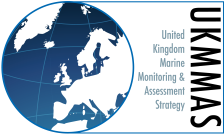Biological effects (bile metabolite) in fish
The assessment indicates that flatfish in the UK portions of the Greater North Sea and the Celtic Seas generally have no significant exposure to polycyclic aromatic hydrocarbons. Every assessment at all monitoring stations met the associated target threshold value.
Background
UK target on biological effects (bile metabolite) in fish
This indicator is used to supplement the target covering the biological effects of contaminants set out in the Marine Strategy Part One (HM Government, 2012), which requires that for biological effects “the intensity of those biological or ecological effects due to contaminants agreed by OSPAR as appropriate for MSFD purposes are below the toxicologically-based standards”. Whilst this indicator has not yet been agreed by OSPAR for Marine Strategy Framework Directive (European Commission, 2008) purposes, it provides valuable information on the exposure of fish to polycyclic aromatic hydrocarbons and has therefore been included in the assessment of Good Environmental Status for contaminants.
Key pressures and impacts
In the UK Initial Assessment (HM Government, 2012), the key pressures associated with this indicator were riverine and direct inputs of polycyclic aromatic hydrocarbons arising from point and diffuse sources, atmospheric deposition (Figure 1) and acute events that have entered marine sediments which can then accumulate in fish and mussels (biota). These are still relevant.

Figure 1. An example of atmospheric inputs of contaminants into the environment.
Measures taken to address the impacts
There is a robust UK legislative framework in place for controlling and reducing pollution from contaminants, including appropriate consenting and monitoring programmes, which is described in the UK Marine Strategy Part Three (HM Government, 2015). However, many of the contaminants that fish are exposed enter the sea before many of the controls were put in place and, due to their persistence, are still present. Removing these from the sea is not considered to be a practicable option.
Monitoring, assessment and regional co-operation
Areas that have been assessed
Status and trends assessments were conducted for the UK portion of the Greater North Sea and Celtic Seas Marine Strategy Framework Directive sub-regions, and at the smaller scale of the 8 UK biogeographic marine regions set out in Charting Progress 2 (UKMMAS, 2010).
Monitoring and assessment methods
Risk-based monitoring and assessment of the status and trends of 1-hydroxypyrene equivalent concentrations in fish was conducted within the annual UK Clean Seas Environmental Monitoring Programme using methods and principles set out in the OSPAR Co-ordinated Environmental Monitoring Programme. The assessment analysed both results of individual monitoring stations and synthesised the result to assess trends on the biogeographic regional level.
Assessment thresholds
Most biological effects are OSPAR candidate indicators, as not all countries use them in environmental monitoring. OSPAR has developed species-specific Background Assessment Concentrations criteria and Environmental Assessment Criteria (OSPAR Commission, 2009) to assess 1-hydroxypyrene equivalent concentrations in fish bile (Figure 2). OSPAR has an aspirational ultimate objective to achieve the background concentrations, which naturally occur in the marine environment (Background Assessment Criteria). Whilst not being a target described in the UK Marine Strategy Part One (HM Government, 2012), the status and trend results were used to examine progress towards this objective.

Figure 2. Dissection of Bile to analyse 1-hydroxypyrene equivalent in flatfish.
Regional co-operation
Although this is not an OSPAR indicator, the UK and OSPAR are working together in the development, monitoring and assessment of this indicator.
Further information
Within the United Kingdom, the Clean Seas Environment Monitoring Programme is one means by which our national and international commitments to monitor marine biota in near-shore and offshore marine waters are met (Nicolaus and others, 2016). The main drivers for the current programme are the Co-ordinated Environmental Monitoring Programme and Joint Assessment and Monitoring Programme of the OSPAR Convention (OSPAR Commission, 2014), together with the European Union Marine Strategy Framework Directive (European Commission, 2008) and Water Framework Directive (European Commission, 2000). Within the Clean Seas Environment Monitoring Programme, the UK monitors contaminants and their biological effects in flatfish (mainly dab but also including flounder and plaice) from around British seas. The measurement of 1-hydroxypyrene equivalent concentration gives a sensitive and integrated measure of exposure to hazardous substances and provides information to assess progress towards this target.
As stated in the UK Marine Strategy, Part One (HM Government, 2012): “Contaminants can enter the marine environment from natural sources and because of anthropogenic activities, either as direct inputs or via rivers, estuaries and the atmosphere. Pollution itself is the introduction of substances which have, or are likely to have, deleterious effects on the marine environment and its uses. This includes effects that result in harm to the health of organisms, loss of biodiversity, are hazardous to human health, impair water quality, and reduce our ability to use the sea.”
Polycyclic aromatic hydrocarbons are formed during both natural and anthropogenic combustion processes. They constitute many individual compounds, several of which are acutely toxic and/or carcinogenic/mutagenic at low concentration. Fish are exposed to polycyclic aromatic hydrocarbons both via uptake across gill surfaces and from their diet, but do not generally accumulate high concentrations as they possess an effective mixed-function oxygenase system, which allows them to metabolise them and to excrete them in bile (Stagg and others, 1995; Richardson and others, 2001). Therefore, measuring the concentrations of 1-hydroxypyrene equivalent in the bile of fish is useful for biomonitoring purposes because its concentrations provide an indication of recent polycyclic aromatic hydrocarbon exposure in fish.
The concentrations of several of these substances have long been monitored in flatfish as part of the UK marine monitoring programme. The additional use of biological effects monitoring allows an integrative measure of the impacts caused by the mixtures of contaminants found in the marine environment. The UK has monitored 1-hydroxypyrene equivalent concentrations in bile to assess the exposure of fish to polycyclic aromatic hydrocarbons, since 2000, as part of the routine annual monitoring surveys.
The UK has also been active within OSPAR and the International Council for the Exploration of the Sea (ICES) to develop an integrated assessment framework for contaminants and their biological effects (Davies and Vethaak, 2012; OSPAR Commission, 2016; Vethaak and others, 2017), including an extensive practical workshop to test this at the Regional Seas scale (Hylland and others, 2017a, Hylland and others, 2017b; Robinson and others, 2017; Vethaak and others, 2017).
Assessment method
This 2016 assessment of the Clean Seas Environmental Monitoring Programme data describes the trends and status of 1-hydroxypyrene equivalent concentrations in biota at monitoring stations around the UK. Assessments are made for many time series, each of a single determinand in a single species at a single monitoring station. This section describes how the results of the individual time series are synthesised to assess status and trends at the biogeographic regional level. It considers 1-hydroxypyrene equivalent in biota. The regional assessment only considers coastal and offshore stations and excludes estuarine stations. The results are therefore based on the monitoring data collected within the waters assessed under the Marine Strategy Framework Directive (European Commission, 2008). The locations of monitoring stations where there are suitable data are shown in Figure 3. The number of time series in each biogeographic region is given in Table 1.
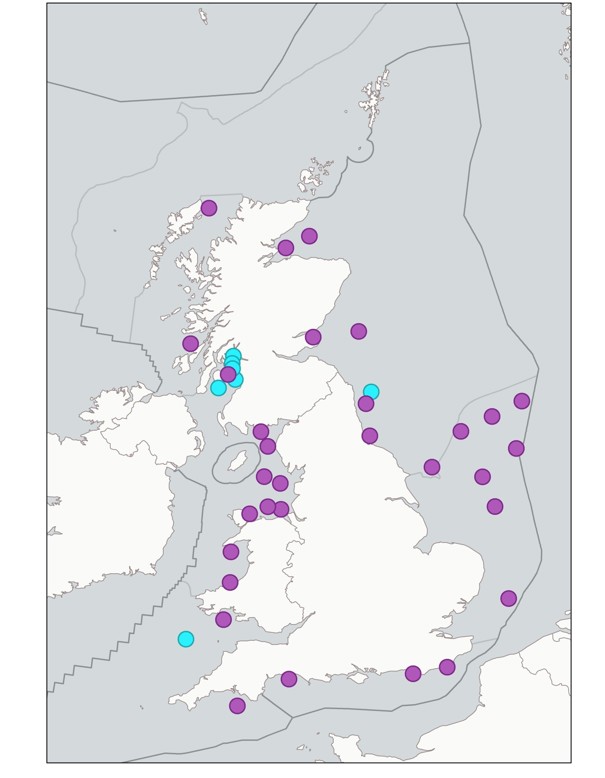
Figure 3. Trend and status (purple) and status only (blue) monitoring stations used to assess 1-hydroxypyrene equivalent concentrations in biota. The areas delineated by the thinner black lines are the biogeographic regions; those delineated by the thicker black lines are the Marine Strategy Framework Directive sub-regions.
Table 1. Number of time series within each sub-region used in the assessment of status and tends
|
Marine Strategy Framework Directive sub-region |
Biogeographic region |
Status assessment |
Trend assessment |
|
Greater North Sea |
Northern North Sea |
8 |
7 |
|
|
Southern North Sea |
7 |
7 |
|
|
Eastern Channel |
3 |
3 |
|
Celtic Seas |
Minches & West Scotland |
1 |
2 |
|
|
Irish Sea |
9 |
10 |
|
|
Western Channel & Celtic Sea |
3 |
2 |
Areas that have been assessed
Status and trends assessments were conducted for the UK portion of the Greater North Sea and Celtic Seas Marine Strategy Framework Directive sub-regions, and at the smaller scale of the 8 UK biogeographic marine regions set out in Charting Progress 2 (UKMMAS, 2010).
Assessment of 1-hydroxypyrene equivalent in flatfish
The concentrations of 1-hydroxypyrene equivalent were monitored in fish. Samples were taken in annual monitoring surveys based on the sampling frequencies specified in the OSPAR Joint Assessment and Monitoring Programme guideline (OSPAR Commission, 2016). Sampling and chemical analysis methodologies met the relevant OSPAR requirements, whilst assessments of status and trends were also based on OSPAR methodologies. The number of time series sampled for the various assessments can be seen in Table 1.
Bile metabolites were measured using synchronous fluorescence spectrometry based on the ICES Techniques in Marine Environmental Sciences series (Ariese and others, 2005). Bile was diluted with 48% ethanol/water and fluorescence spectra obtained for individual samples, quantified against that of a 1-hydroxypyrene calibration standard and the results reported as ng/g 1-hydroxypyrene equivalent biliary concentrations.
An individual time series of 1-hydroxypyrene equivalent concentrations is assessed for status if:
- there is at least one year with data in the period 2010 to 2015
- there are at least three years of data over the whole-time series
- a parametric model can be fitted to the data and used to estimate the mean concentration in the final monitoring year (or, occasionally, if a non-parametric test of status is applied)
The time series is also assessed for trends if, in addition:
- there are at least five years of data over the whole-time series
- a parametric model can be fitted to the data and used to estimate the trend in mean concentrations
Information on how the individual time series as assessed for status and trends is available from the British Oceanographic Data Centre.
For the regional assessment, the results from the individual time series are combined. Essentially, a summary measure of status or trend is obtained from each time series. Mean concentrations significantly below the Background Assessment Criteria are said to be near background. Only biogeographic regions with at least 3 monitoring stations with good geographic spread are considered in the regional assessment.
Assessment thresholds
OSPAR developed Background Assessment Concentrations and Environmental Assessment Criteria (OSPAR Commission, 2009) for 1-hydroxypyrene equivalent (Table 2). Background Assessment Criteria were developed to test whether observed results are near background levels. Similarly, to test if observed results are causing environmental harm, OSPAR also developed Environmental Assessment Criteria (OSPAR Commission, 2009). If the measured concentrations are not significantly below the indicated Environmental Assessment Criteria (Table 2), then the measured organisms may be exposed to concentrations of contaminants that can cause harm.
Table 2. OSPAR Assessment Criteria for the bile metabolite in flatfish. Background Assessment Concentrations and Environmental Assessment Criteria are expressed in nanograms per millilitre (ng/ml). There are currently no assessment criteria for plaice.
|
Fish species |
Determinand |
Determinand symbol and unit |
Background Assessment Criteria |
Environmental Assessment Criteria |
|
Limanda limanda (dab) |
1-hydroxypyrene equivalent (bile) |
PYR1OHEQ (ng/ml) |
150 |
22000 |
|
Platichthys flesus (Flounder) |
1-hydroxypyrene equivalent (bile) |
PYR1OHEQ (ng/ml) |
1300 |
29000 |
Results
Findings in the 2012 UK Initial Assessment
No initial assessment was carried out in 2012. The assessment of 1-hydroxypyrene equivalent in bile was only introduced afterwards as a UK indicator.
Latest findings
Status assessment
Of the 31 status assessments, none were above the Environmental Assessment Criteria (OSPAR Commission, 2009), indicating that polycyclic aromatic hydrocarbons are unlikely to cause adverse biological effects. The mean concentrations across the monitoring stations were below the Environmental Assessment Criteria values for 1-hydroxypyrene equivalent in the Greater North Sea and Celtic Seas and the 6 monitored UK biogeographic regions (Figure 4 and 5). For the Greater North Sea and Celtic Seas all sampled stations stayed significantly below the Environmental Assessment Criteria values meeting the target for this indicator described in the UK Marine Strategy Part One (HM Government, 2012). Overall, there is high confidence in this assessment.
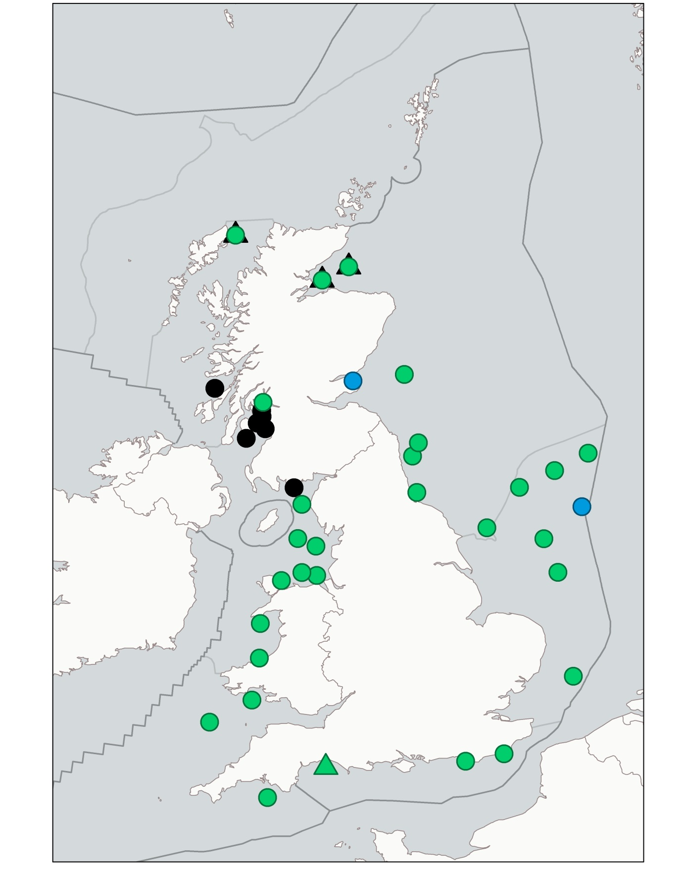
Figure 4. Assessment results by sampling station. Blue: the mean concentration is significantly (p < 0.05) below the Background Assessment Criteria; green: the mean concentration is significantly (p< 0.05) below the Environmental Assessment Criteria; black: there are no assessment criteria available; circle: there is no significant change in mean concentration (p > 0.05); upward triangle: the mean concentration is significantly increasing (p <0.05).

Figure 5. Status assessment in 5 of 8 UK biogeographic sub-regions. All sub-regions show concentrations significantly below the Environmental Assessment Criteria (EAC) threshold.
Trend assessment
Of the 31 trend assessments in the Celtic Seas and Greater North Sea, only 4 showed a significant upward trend, while the other 27 time-series indicated no significant trend. Two of the stations with upwards trends were in the North Sea South and one in the Eastern Channel and one in the Minches and West Scotland. Three out of four assessed regions show a stable situation. Only the Northern North Sea biogeographic region showed an overall significant upward trend.
Further information
Of the time-series analyses in the Celtic Seas and Greater North Sea, 4 (13%) showed a significant upward trend while none showed a significant downward trend, and, none were above the Environmental Assessment Criteria (Table 3; Figure 4) meeting the target described in the UK Marine Strategy Part One (HM Government, 2012) for this indicator.
Table 3. Number of time series with each trend and status by biogeographic region and Marine Strategy Framework Directive sub-region. “<BAC”: the mean concentration is significantly (p 0.05) below the Background Assessment Criteria; “<EAC”: the mean concentration is significantly (p<0.05) below the Environmental Assessment Criteria; “≥ EAC”: the mean concentration is not significantly (p<0.05) below the Environmental Assessment Criteria.
|
Marine Strategy Framework Directive sub-region |
Biogeographic region |
Trend assessment |
1-hydroxypyrene equivalent Time Series |
Status assessment* |
1-hydroxypyrene equivalent Status stations |
|
Greater North Sea |
Northern North Sea |
upward trend |
2 |
< BAC |
1 |
|
no trend |
5 |
< EAC |
7 |
||
|
downward trend |
0 |
≥ EAC |
0 |
||
|
Southern North Sea |
upward trend |
0 |
< BAC |
1 |
|
|
no trend |
7 |
< EAC |
6 |
||
|
downward trend |
0 |
≥ EAC |
0 |
||
|
Eastern Channel |
upward trend |
1 |
< BAC |
0 |
|
|
no trend |
2 |
< EAC |
3 |
||
|
downward trend |
0 |
≥ EAC |
0 |
||
|
total |
upward trend |
3 |
< BAC |
2 |
|
|
no trend |
14 |
< EAC |
16 |
||
|
downward trend |
0 |
≥ EAC |
0 |
||
|
Celtic Seas |
Minches & West Scotland |
upward trend |
1 |
< BAC |
0 |
|
no trend |
1 |
< EAC |
1 |
||
|
downward trend |
0 |
≥ EAC |
0 |
||
|
Irish Sea |
upward trend |
0 |
< BAC |
0 |
|
|
no trend |
10 |
< EAC |
9 |
||
|
downward trend |
0 |
≥ EAC |
0 |
||
|
Western Channel & Celtic Sea |
upward trend |
0 |
< BAC |
0 |
|
|
no trend |
2 |
< EAC |
3 |
||
|
downward trend |
0 |
≥ EAC |
0 |
||
|
total |
upward trend |
1 |
< BAC |
0 |
|
|
no trend |
13 |
< EAC |
13 |
||
|
downward trend |
0 |
≥ EAC |
0 |
The regional trend assessment shows that the Northern North Sea has increased significantly over the most recent assessment time scale (Figure 6), while the 3 other biogeographic regions for which enough data was available make a trend assessment stayed stable. A total of 4 stations for different fish species showed significant upward trends (Table 4). Two of the stations are in the Northern North Sea, one in the English Channel and one in the Minches and West Scotland biogeographic region.
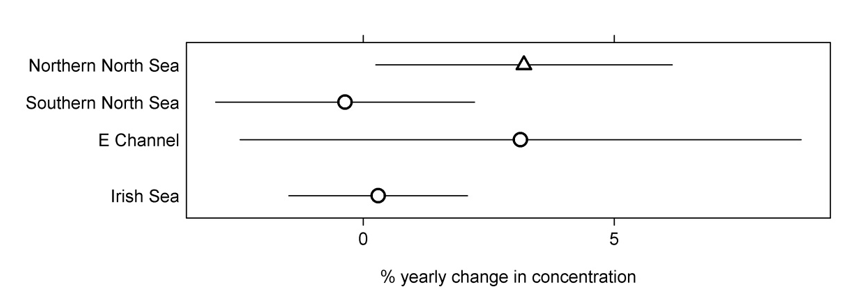
Figure 6. Trends in the 4 UK biogeographic sub-regions for which sufficient data are available to assess. Most sub-regions show static trends (circles), only the Northern North Sea shows an increasing trend (upward triangle).
Table 4. Stations where a significant upward trend was observed within a specific species.
|
Station |
Species |
MSFD region |
Biogeographic region |
|
EastChan_ECInterW_fi01 |
Common Dab |
Greater North Sea |
Eastern Channel |
|
MinchMalin_TheMinchNorth_fi02 |
European Plaice |
Celtic Seas |
Minches & West Scotland |
|
MorayF_MoFOpenSea_fi01 |
European Plaice |
Greater North Sea |
Northern North Sea |
|
MorayF_MorayFirthOffshor_fi01 |
Eurpoean Plaice |
Greater North Sea |
Northern North Sea |
Status Assessment
The overall status of the Greater North Sea and Celtic Sea sub-region indicates that 1-hydroxypyrene equivalent concentrations are below the Environmental Assessment Criteria and that no significant effects from exposure to polycyclic aromatic hydrocarbons are expected. All individual stations stayed significantly below the Environmental Assessment Criteria threshold (Figure 7) meeting the target for this indicator described in the UK Marine Strategy Part One (HM Government, 2012). Two stations in the Northern North Sea and Southern North Sea were also significantly below the OSPAR Background Assessment Criteria threshold, although exposure to polycyclic aromatic hydrocarbons was generally above background. In a similar way to this screening assessment of the exposure of fish to polycyclic aromatic hydrocarbons, the assessments of polycyclic aromatic hydrocarbon concentrations in shellfish showed that generally, the assessed regions were significantly below the Environmental Assessment Criteria thresholds for the individual compounds. For polycyclic aromatic hydrocarbon concentrations in sediments, the Western Channel region was not significantly below the Environmental Assessment Criteria threshold. Nevertheless, no significant effects were observed in the sampled fish.
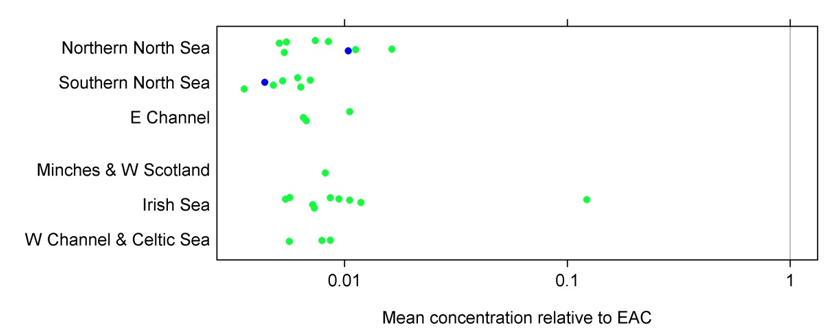
Figure 7. Individual time series Environmental Assessment Criteria (EAC) status assessment in 6 of 8 UK biogeographic sub-regions. Blue: the mean concentration is significantly (p<0.05) below the Background Assessment Concentration; green: the mean concentration is significantly (p<0.05) below the Environmental Assessment Criteria.
Conclusions
The concentrations of polycyclic aromatic hydrocarbon metabolites in fish bile (as 1-hydroxypyrene equivalents) have been static overall for both the Greater North Sea and Celtic Seas. The status assessment showed that all assessments met the target for this indicator described in the UK Marine Strategy Part One (HM Government, 2012).
Further information
There were a small number of sites where increasing concentrations of 1-hydroxypyrene equivalents were observed, mostly in the Northern North Sea region. This assessment indicates an acceptable level of exposure to polycyclic aromatic hydrocarbons by flatfish in UK coastal and offshore waters, which is supported by the observations of low levels of EROD detoxification enzyme activity in flatfish from these areas. Mixed polycyclic aromatic hydrocarbon concentrations were observed in sediments (assessment failure in the Western Channel region) and shellfish (all regions were significantly below the Environmental Assessment Criteria. In conclusion, some polycyclic aromatic hydrocarbon sediment failures, did not show any significant biological effects in the sampled flatfish in the UK portions of the Marine Strategy Framework Directive Celtic Seas and Greater North Seas. Overall, there is high confidence in this assessment.
Knowledge gaps
No significant knowledge gaps.
References
Ariese F, Beyer J, Jonsson G, Porte Visa C, Krahn MM (2005) ‘Review of Analytical Methods for Determining Metabolites of Polycyclic Aromatic Compounds (PACs) in Fish Bile’ ICES Techniques in Marine Environmental Sciences, Number 39, 41 pages (viewed on 10 December 2018)
Davies IM, Vethaak AD (2012) ‘Integrated marine environmental monitoring of chemicals and their effects’ ICES Cooperative Research Report Number 315, 277 pages (viewed on 10 December 2018)
European Commission (2000) ‘Directive 2000/60/EC of the European Parliament and of the Council establishing a framework for the Community action in the field of water policy’ Official Journal of the European Union L 327, 22122000, pages 1–73 (viewed on 16 November 2018)
European Commission (2008) ‘Directive 2008/56/EC of the European Parliament and of the Council of 17 June 2008 establishing a framework for community action in the field of marine environmental policy (Marine Strategy Framework Directive)’ Official Journal of the European Union L 164, 2562008, pages 19-40 (viewed on 16 November 2018)
HM Government (2012) ‘Marine Strategy Part One: UK Initial Assessment and Good Environmental Status’ (viewed on 5 July 2018)
HM Government (2015) ‘Marine Strategy Part Three: UK Programme of Measures’ (viewed on 5 July 2018)
Hylland K, Burgeot T, Martínez-Gómez C, Lang T, Robinson CD, Svavarsson J, Thain JE, Vethaak AD, Gubbins MJ (2017a) ‘How can we quantify impacts of contaminants in marine ecosystems? The ICON project’ Marine Environmental Research 124:2-10 (viewed on 10 December 2018)
Hylland K, Robinson CD, Burgeot T, Martínez-Gómez C, Lang T, Svavarsson J, Thain JE, Vethaak AD, Gubbins MJ (2017b) ‘Integrated chemical and biological assessment of contaminant impacts in selected European coastal and offshore marine areas’ Marine Environmental Research, 124:130-138 (viewed on 10 December 2018)
Nicolaus EEM, Wright SR, Bolam TPC, Barber JL, Bignell JP, Lyons B (2016) ‘Spatial and temporal analysis of the risks posed by polychlorinated biphenyl and metal contaminants in dab (Limanda limanda) collected from waters around England and Wales’ Marine Pollution Bulletin, 112(1-2):399-405 (viewed on 10 December 2018)
OSPAR Commission (2009) ‘Background Document on CEMP Assessment Criteria for QSR 2010’ OSPAR Publication 461/2009. ISBN 978-1-907390-08-1 (viewed on 8 December 2018)
OSPAR Commission (2014) ‘OSPAR Joint Assessment and Monitoring Programme (JAMP) 2014 – 2021’ Ospar Agreement 2014-02 (viewed on 27 November 2018)
OSPAR Commission (2016) ‘Trial application of the OSPAR JAMP Integrated Guidelines for the Integrated Monitoring and Assessment of Contaminants’ Publication Number 678, OSPAR Commission, London, UK (viewed on 10 December 2018)
Richardson DM, Davies IM, Moffat CF, Pollard P, Stagg RM (2001) ‘Biliary PAH metabolites and EROD activity in flounder (Platichthys flesus) from a contaminated estuarine environment’ Journal of Environmental Monitoring 3: 610 – 615 (viewed on 10 December 2018)
Robinson CD, Webster L, Martínez-Gómez C, Burgeot T, Gubbins MJ, Thain JE, McIntosh AD, Vethaak AD, Hylland K (2017) ‘Assessment of contaminant concentrations in sediments, fish and mussels sampled from the North Atlantic and European regional seas within the ICON project’ Marine Environmental Research 124: 21-31 (viewed on 10 December 2018)
Stagg RM, McIntosh AM, Mackie P (1995) ‘The induction of hepatic mono-oxygenase activity in dab (Limanda limanda) in relation to environmental contamination with petroleum hydrocarbons in the North Sea’ Aquatic Toxicology 33: 254-264 (viewed on 10 December 2018)
UKMMAS (2010) 'Charting Progress 2: An assessment of the state of the UK seas' Published by Defra on behalf of the UK Marine Monitoring and Assessment Strategy community (viewed on 4 January 2018)
Vethaak AD, Davies IM, Thain JE, Gubbins MJ, Martínez-Gómez C, Robinson CD, Moffat CF, Burgeot T, Maes T, Wosniok W, Giltrap M, Lang T, Hylland K (2017) ‘Integrated indicator framework and methodology for monitoring and assessment of hazardous substances and their effects in the marine environment’ Marine Environmental Research 124: 11-20 (viewed on 10 December 2018)
Acknowledgements
Assessment metadata
| Assessment Type | UK Marine Strategy Framework Directive Indicator Assessment |
|---|---|
D8 | |
D8.2 Effects of Contaminants | |
Marine Strategy Part One | |
| Point of contact email | marinestrategy@defra.gov.uk |
| Metadata date | Saturday, September 1, 2018 |
| Title | Biological effects (bile metabolite) in fish |
| Resource abstract | The assessment indicates that flatfish in the UK-portions of the Greater North Sea and the Celtic Sea generally have no significant exposure to polycyclic aromatic hydrocarbons. |
| Linkage | In addition to links provided in ‘References’ section above:ICES (2011) ‘Report of the Study Group on Integrated Monitoring of Contaminants and Biological Effects (SGIMC)’ 14-18 March 2011, Copenhagen, Denmark. Document identifiers: ICES CM 2011/ACOM:30 265 pp. |
| Conditions applying to access and use | © Crown 2018 copyright Defra, licenced under the Open Government Licence (OGL). |
| Assessment Lineage | The 2016 assessment of the UK's Clean Seas Environment Monitoring Programme described the status and trends of contaminant concentrations and biological effects measurements in biota and sediment at monitoring stations in waters around the UK. Assessments were made for a large number of time series, typically each of a single contaminant in a single species (for biota) at a single monitoring station. The results of the individual time series at coastal and offshore stations were synthesised to assess status and trends at the biogeographic regional level and formed the basis of this indicator. Data were submitted to the MERMAN database by relevant Competent Monitoring Authorities. A series of templates were populated by submitting officers and submitted to the database which has in-built data restrictions and a data filter to ensure high quality, accurate data are submitted. The data filter has formulae in-built which use Accredited Quality Control information from known standards, limits, standard deviations and/or inter laboratory calibration exercises to calculate a score. Only data that passed a threshold agreed with the national advisory bodies were used for assessments. The data for 1999 - 2015 were extracted from MERMAN. Further data checks were made and records with obvious errors were deleted or corrected. The data were standardised to agreed units and bases of a single metabolite in a single species at a single monitoring station. Time series with no data for the period 2010 - 2015 were excluded. The individual time series were assessed for both trends and status. The methods behind the assessments and the individual time series results available from the British Oceanographic Data Centre. The results of the individual time series at coastal and offshore stations were then synthesised to assess status and trends at the biogeographic regional level. The methods and results available from the British Oceanographic Data Centre. |
| Dataset metadata | http://portal.oceannet.org/portal/start.php#details?tpc=012_Marine_Scotland_FishDAC_12111 |
| Dataset DOI |
The Metadata are “data about the content, quality, condition, and other characteristics of data” (FGDC Content Standard for Digital Geospatial Metadata Workbook, Ver 2.0, May 1, 2000).
Metadata definitions
Assessment Lineage - description of data sets and method used to obtain the results of the assessment
Dataset – The datasets included in the assessment should be accessible, and reflect the exact copies or versions of the data used in the assessment. This means that if extracts from existing data were modified, filtered, or otherwise altered, then the modified data should be separately accessible, and described by metadata (acknowledging the originators of the raw data).
Dataset metadata – information on the data sources and characteristics of data sets used in the assessment (MEDIN and INSPIRE compliance).
Digital Object Identifier (DOI) – a persistent identifier to provide a link to a dataset (or other resource) on digital networks. Please note that persistent identifiers can be created/minted, even if a dataset is not directly available online.
Indicator assessment metadata – data and information about the content, quality, condition, and other characteristics of an indicator assessment.
MEDIN discovery metadata - a list of standardized information that accompanies a marine dataset and allows other people to find out what the dataset contains, where it was collected and how they can get hold of it.
Recommended reference for this indicator assessment
E.E. Manuel Nicolaus1, Craig D. Robinson2 and Rob Fryer2 2018. Status assessment for biological effects (Bile metabolite) in fish. UK Marine Online Assessment Tool, available at: https://moat.cefas.co.uk/pressures-from-human-activities/contaminants/bile-metabolites/
1Centre for Environment, Fisheries and Aquaculture Science
2Marine Scotland
